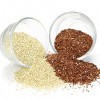Abstract
The U.S. Department of Agriculture’s MyPlate nutrition guide recommends that Americans consume half of their grains from whole grain foods. Whole wheat bread and oatmeal are whole grain foods that are familiar to most Americans, but lots of other whole grain foods are also available. An example of an unfamiliar whole grain food is quinoa (pronounced keen-wa). Quinoa is a nutritious seed that is simple to prepare. It can be served as a hot cereal or side dish, as a cold salad similar to pasta salad, or it can be used in recipes in place of rice or other grains. It also has the advantage of being gluten free, which is a must for people diagnosed with celiac disease. Follow the link to learn more about quinoa and what it has to offer. This 3-page fact sheet was written by Alexandra Dati, Gail Kauwell, and Amy Simonne, and published by the UF Department of Family, Youth and Community Sciences, May 2014.
References
DeGeyter, E., Lambert, E., Geelen, D., Smagghe, G. 2007. Novel Advances with Plant Saponins as Natural Insecticides to Control Pest Insects. Pest Technology. 1(2), 96-105.
Dixit, A., Azar, K., Gardner, C., Palaniappan, L. 2011. Incorporation of Whole, Ancient Grains into a Modern Asian Indian Diet to Reduce the Burden of Chronic Disease. Nutrition Reviews. 69(8), 479-488. DOI: 10.1111/j.1753-4887.2011.00411.x. https://doi.org/10.1111/j.1753-4887.2011.00411.x
Grains. United States Department of Agriculture. n.d. Retrieved from http://choosemyplate.gov/food-groups/grains.html.
National Nutrient Database for Standard Reference. Release 26 United States Department of Agriculture. 2013. Retrieved from http://ndb.nal.usda.gov/ndb/search/list.
Repo-Carrasco, R., Espinoza, C., & Jacobsen, S.E. 2003. Nutritional Value and Use of the Andean Crops Quinoa (Chenopodium quinoa) and Kañiwa (Chenopodium pallidicaule). Food Reviews International, 15(1&2), 179-189. DOI: 10.1081/FRI-120018884. https://doi.org/10.1081/FRI-120018884
Ruales, J. & Nair, B.M. 1992. Nutritional quality of the protein in quinoa (Chenopodium quinoa, Willd) seeds. Plant Foods for Human Nutrition, (42)1-11. https://doi.org/10.1007/BF02196067
Types of quinoa. 2013. Retrieved from http://wholegrainscouncil.org/whole-grains-101/types-of-quinoa.
Vega-Gálvez, A., Miranda , M., Vergara, J., Uribe, E., Puente, L., & Martinez, E. 2010. Nutrition facts and functional potential of quinoa (Chenopodium quinoa willd.), an ancient andean grain: a review. Journal of the Science of Food and Agriculture, 90(15): 2541-2547. doi: 10.1002/jsfa.4158. https://doi.org/10.1002/jsfa.4158

